Figure it Out
Look around you. We are surrounded by numbers. With a little bit of imagination, you can create a whole host of activities to help your child's numeracy development. So go figure it out with some fun number play. Below are some great examples to get you going.
Free the Vegetables – Jason McLean
The Villains have trapped the poor vegetables in the bottle. It is the Superhero’s job to free the vegetables.
Learning Intention
Begin to understand the operation of add/subtract and use the related vocabulary. Begin to use the +/- and = sign to record mental calculation in a number sentence, recognise the use of the symbols to stand for an unknown number
Resources
Old bottle, 20 vegetables (small or pieces, paper, pencil, crayon, playdough or felt-tip and number cards (these can also just be handwritten and cut out)
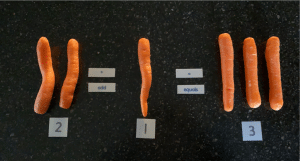 Activity
Activity
1. Help free the Vegetables from the bottle by guessing how many there are.
2 As your child guesses the amount you may remove the number of vegetables from the bottle, place them on a page and allow them to write the number below them.
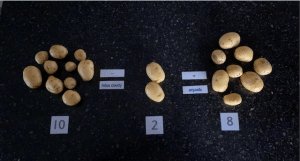 3. Your child may also brainstorm/predict a series of amounts they think are in the bottle.
3. Your child may also brainstorm/predict a series of amounts they think are in the bottle.
4. Once all the vegetables are free from the bottle add/subtract different amounts using the +/- and = signs (see how many different answers your child can get).
Extension
Record and sequence numbers 1-20. Work on both number recognition, addition and subtraction. Help your child learn that making mistakes is ok. You become playful in their work making silly mistakes allowing them to correct you.
Jaffa Cake Maths – Heather McKee
A simple and effective activity to help young children understand the story of 10 using some delicious Jaffa Cakes!
Learning Intention
To understand the story of 10 (can also be used to understand the story of 3,4,5,6,7,8 & 9)
Resources
A packet of Jaffa Cakes or Chocolate Digestives
Activity
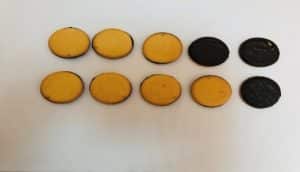 1. Open a packet of Jaffa Cakes and place 10 of them chocolate side down like so:
1. Open a packet of Jaffa Cakes and place 10 of them chocolate side down like so:
2. Turn one Jaffa Cake over so your child can see that 1 + 9 = 10
3. Turn over the second Jaffa Cake so it is clear that 2 + 8 = 10
4. Enjoy continuing with this process, although your child may beat you to it and challenge you before you challenge them. Here are a few more examples of outcomes you will come up with.
5. Enjoy eating the Jaffa Cakes together.
Combining Sets in the Great Outdoors! – Mairead McElroy
This activity explores ways of combining sets using natural materials to make 5 and using Numicon to further identify the set they have created.
Learning Intention:
- Investigate different ways of making sets to 5.
- Understanding Numicon to represent the sets of 5.
Resources:
- Paper Numicon shapes to 10.
- Digit numbers and addition symbols.
Activity:
- Ask children to create a 5 square frame using sticks.
- Take the opportunity during a nice walk to collect two different kinds of natural resources which will represent the amount in your sets.
- Ask children to combine the two different kinds of natural resources in the number grid to show how they can make the number five.
- The example shown displays two stones plus three leaves make five (2+3=5).
- You could also write the numerals on pieces of paper for the child to place under their sets as shown here.
- If children use Numicon (print outs available online or make them) in school ask them to recognize and identify where they would fit into the sum they have created (you can check they are the correct Numicon by counting the holes in each of them.
- Encourage children to see if they can find other ways to make five and maybe keep a note of these through pictures or writing.
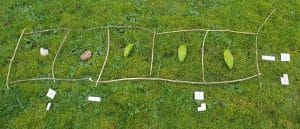
Progression/Follow up Activity:
- If you have found that children have mastered to 5 with confidence, create a 10 square frame with the sticks and explore combining sets to make 10.
Lego Number Bonds to 10! – Megan Morgan
If your child loves Lego, this will be a great activity for them! Use the Lego you have (or any alternative) to represent the number bonds to 10!
Learning Intentions:
Investigate different ways for making sets of 10
To carry out simple mental calculations
Activity:
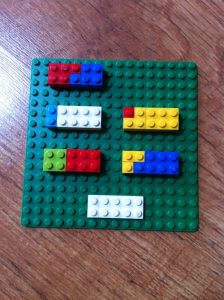 1. Get your child to make the number 10 with their Lego. There are many different variations they can make!
1. Get your child to make the number 10 with their Lego. There are many different variations they can make!
2. Discuss with your child how their representation of 10 is made up e.g. it might be 4+6.
3. Challenge them to find a different way of making 10. This time they might do 5+5.
4. Challenge them to make all of the number bonds to 10!
1+9 2+8 3+7 4+6 5+5 6+4 7+3 8+2 9+1
5. Encourage them to notice any patterns that are emerging from their Lego!
Activity Extension/Alternative:
Have a go at number bond building on this website: https://mathsbot.com/manipulatives/rods
If your child is familiar with Numicon this is also a good resource: https://mathsbot.com/manipulatives/numberFrames
For older children this game will test their number bond knowledge: https://www.twinkl.co.uk/go/resource/T-GO-01-number-bonds-1-to-10
Superhero Maths Game Catch a Villain – Jason McLean
This game has a great deal of learning although you can carry it out in a fun way with your child. This Superhero Maths game practices number recognition, counting, addition, and gets the children moving. Help the Superhero’s catch those villains!
The Back Story or Plot of the Game
The villains have robbed a bank and stolen lots of gold coins. Your job as the Superhero is to catch the villains and bring back the coins.
Learning Intention
Begin to understand and use the vocabulary of comparing and ordering numbers. Compare two familiar numbers, say which is more or less, and give a number which lies between them.
Required Resources
Pipe Cleaners/straws/villain toys/and or create your own drawing (for the villain’s); Card (for the gold coins) or it can be a colour of your child’s choice; Die or Number cards
Activity
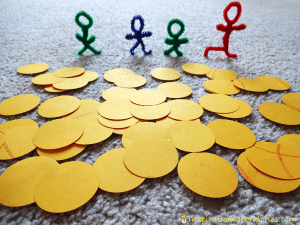 Make the villains from the pipe cleaners and punch out 50 gold circles with a small circle punch. Write the numbers 1-5 on the gold coins. Most of the coins have the number 1 or 2 (so you can practice adding small numbers). You will roll the die or use number cards to see how many coins you will collect.
Make the villains from the pipe cleaners and punch out 50 gold circles with a small circle punch. Write the numbers 1-5 on the gold coins. Most of the coins have the number 1 or 2 (so you can practice adding small numbers). You will roll the die or use number cards to see how many coins you will collect.
1. Place the villains and coins on one side of the room.
2. Have your Superhero child start on the other side of the  room. Roll the die. (You could also choose a number card or just call out a number). The number on the die tells you how many gold coins you recover from the villain.
room. Roll the die. (You could also choose a number card or just call out a number). The number on the die tells you how many gold coins you recover from the villain.
3. The Superhero runs across the room and catches one of the villains. Gather gold coins from the pile (based on the number rolled). Run back to the start.
4. Help the Superhero add up the numbers on the gold coins.
5. Go catch another villain! (Roll the die and start again).
Extension
Work on just number recognition. Write numbers that your child needs to work on.
Work on just counting. Make each gold coin worth only 1. Grab a handful of coins each time a villain is caught. Count the gold coins collected.
Number Hunt – Louise Orr
Learning Intentions
Develop recognition of the number that comes before or after a given number, up to the number 10.
Resources
The numbers 1-10 on individual pieces of paper.
A wipeable board / page with a marker.
Activity
- Cut 10 small squares of paper (allow your child to help with the cutting and numbering pieces of paper).
- Mark each one with a number, until you have the numbers 1 -10.
- Place the numbers in various places around the house or in the garden.
- Use a small wipeable board / page with a marker and give your child a written clue to the number they need to find. For example, “1 more than 5” or “1 less than 3”.
- Encourage your child to go in search for the number which is the answer to your clue.

Order It – Colleen Megarry
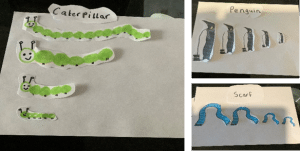 An exciting and creative way for the child to explore and learn the mathematical skill of ordering according to size, while also using their imagination to create their very own characters of interest.
An exciting and creative way for the child to explore and learn the mathematical skill of ordering according to size, while also using their imagination to create their very own characters of interest.
Learning Intention
To sort through and compare objects of different sizes. Then order them according to largest to smallest or smallest to largest.
Resources
Paper, scissors, colouring pencils/pens
Activity
1. Decide what character or picture you want to make. Then draw up to five of them.
2. Create your own design. Each one can have the same design or a different one, it’s up to you, but remember to make them all different in size.
3. Now cut out the pictures and place them flat down.
4. Carefully compare which picture is the tallest. Then compare each picture to the one before. They should be reducing smaller in size, until you reach the smallest picture of all.
5. Have fun practising and ordering in size from largest to smallest. Then when able try to order the pictures from smallest to largest.
6. Create new drawings to maintain interest in comparing and ordering.
Tin Foil Fun! – Mairead McElroy
Children can enjoy a sensory experience in practicing their numeral formation.
Learning Intentions:
- Recognize and write numerals 1-10.
Resources:
- Tin Foil.
- Paint or shaving foam.
- Paint brush or cotton bud.
Activity:
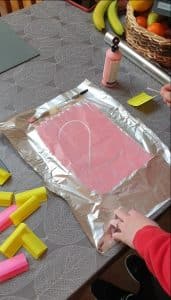 Provide children with a small amount of tin foil and paint, if not readily available shaving foam will work just as well.
Provide children with a small amount of tin foil and paint, if not readily available shaving foam will work just as well.- Add a small amount of paint or shaving foam and spread across the tin foil.
- Write the numbers 1-10 on post-it notes with the children and let the child randomly select one.
- Encourage them to identify the number first.
- Using the paint brush, a cotton bud or their finger encourage them to write the numbers.
- The child could then take photographs of their work or try and print the number onto a separate piece of paper by simply pressing over their number with a separate page.
- The paint on the tin foil can then be brushed away and the child can pick a new number and start again.
- When finished with the tin foil why not try and get the child to mould the numbers, adding another element of fun to the activity.
Progression/Follow up activity:
- If none of these items are available at home children can still practice involving members of their households.
- This can be done by sitting on the floor facing each other’s backs and tracing a number on the person’s back in front of you for the person to guess what number you have traced. Roles can be swapped so the child gets a turn at guessing and practicing tracing.
Let’s Get Measuring! – Eirinn McCrudden
Create your own measuring tape to measure some of your toys or items in your house! I wonder which will be the tallest…
Learning Intention:
Compare objects of different length.
Use and show understanding of comparison language, EG: longer/shorter, taller/smaller.
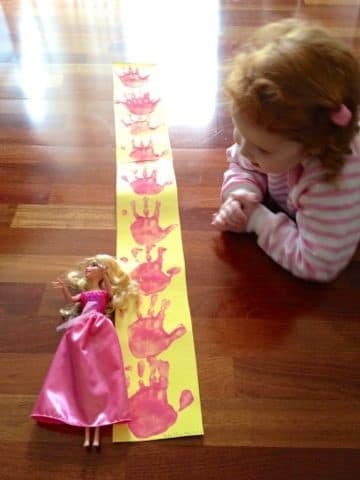 Activity:
Activity:
1. Attach some pages or cardboard together in a line using glue or Sellotape (if you have an old roll of wallpaper, this will work too!)
2. Assist your child in painting their hands and stamp onto your paper like shown in the picture. Or if you don’t have paint, you could also use markers, pencils or crayons to draw around their hands instead. (If needed or the child wants you to can also number the handprints to assist them when counting!)
3. Ask your child to pick 2 toys or any other household items at the most to measure and compare (they can change the items 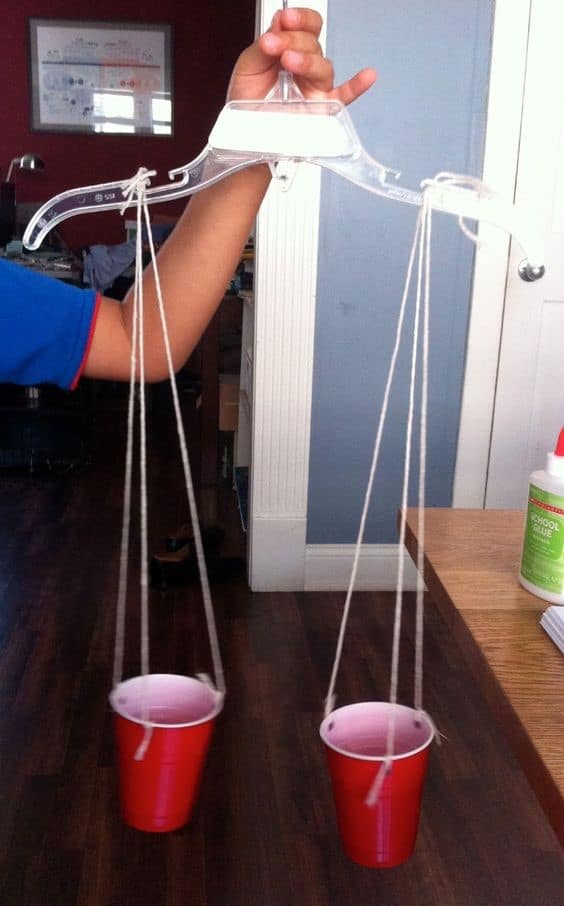 once they’ve both been measured, however only allow them 2 items at the start to keep it simple!).
once they’ve both been measured, however only allow them 2 items at the start to keep it simple!).
4. Make sure your child has their toy level with the bottom of the page and count how many handprints tall the item is. During this stage, your child can take a photo or write their findings on a page to record how many handprints tall the items are.
Extension: If your child has really enjoyed this activity and would like to continue measuring, you could weigh and compare items too! Be sure to use the comparison language also such as heavy/light. If you don’t have scales at home, you can DIY your own balancing scales using a hanger, string and plastic cups (see image to left).
NUMBER SWAT – Lindelle McCrory
A great activity with an element of fun to support children’s numeracy and reflexes. Activity can be played with one or two people.
Learning Intention
Develop recognition of number, matching number to sets.
Activity
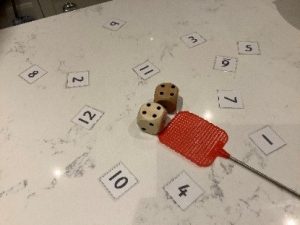 1. Resources: One/two fly swatters/ flippers, 1/ 2 dice and numbers from 1-12.
1. Resources: One/two fly swatters/ flippers, 1/ 2 dice and numbers from 1-12.
2. Firstly, the adult/child can write numbers 1-6 or 1-12 on a piece of paper/card.
3. Next, get your dice and fly swatter ready.
4. Take a turn and roll the dice and swat the number which matches the dice.
5. When you swat a number, you can then remove it from the table. When all the numbers are removed, the game is over.
1 to 8 – Aimee McGleenon
Learning Intention:
To develop recognition of the numerals 1-8
To develop understanding of set representations from 1-8
Activity
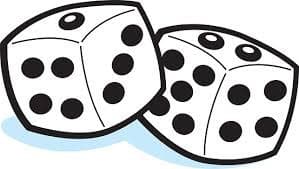 1. Write the numbers from 1-8 on the whiteboard.
1. Write the numbers from 1-8 on the whiteboard.
2. Next, grab some paper and a bowl.
3. On your paper, ask an adult to draw sets of dots or dice like patterns for numbers 1-8 and fold each piece up and place into the bowl.
4. One at a time, pick out a piece of paper and count how many dots there are.
5. Once counted, find the matching number on the whiteboard and erase it.
6. Keep going until the bowl is empty and you have found all the numbers.
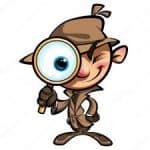 Be a Shape Detective! – Eirinn McCrudden
Be a Shape Detective! – Eirinn McCrudden
Create magnifying glasses in different shapes to investigate and explore around your home to find shapes that match!
Learning Intention:
Explore and talk about shapes within their home environment, describing and naming them or discussing shape properties, IE: roll/ doesn’t roll, has 4 straight edges
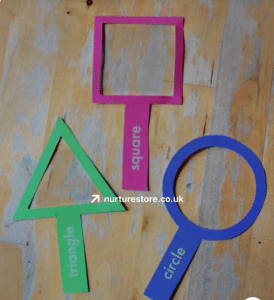 Activity:
Activity:
1. Using paper, a cardboard box or anything you have handy, draw out different shapes with a handle attached to make your own shaped magnifying glasses! You could draw a circle, triangle, square, rectangle, or any other shapes you child might know and like! Talk to your child about which shape is which, but let them take the lead (if they have lots they want to tell you about a shape, let them!)
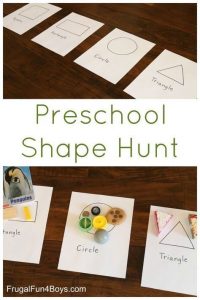 2. Once made, let your child take one magnifying glass at a time to go exploring around your house to find items that match the shape of the magnifying glass, EG: using the rectangle magnifying glass to match with a TV.
2. Once made, let your child take one magnifying glass at a time to go exploring around your house to find items that match the shape of the magnifying glass, EG: using the rectangle magnifying glass to match with a TV.
3. Children could either bring items or tell you about items they found that matched. Question them to further their thinking by asking them questions like, “How do you know it’s a match? Is something the same/different?”. (You could pretend or get things wrong to let the children act as the teacher- they love this!)
Extension: You could tell your child a shape and ask them to go and find something that matches from a specific part of your house, IE: their bedroom. You can switch up which shapes to hunt for. Also, you could read a book about shape (if you have one) or watch a YouTube video such as ‘Numberjacks– very shapely’ at https://www.youtube.com/watch?v=9O5o1k_5UKw&t=757s
Length and Height – Aimee McGleenon
 Learning intentions:
Learning intentions:
To estimate the length or height of items
To measure items using non-standard units of measurement
Activity
1. Chat with an adult and decide on an item to use as your measurement unit. This could be spoons, shoes or anything you have at hand.
2. Collect 8 of these items and line them up.
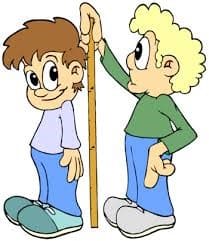 3. Next, collect items to measure from around your house or from outside together.
3. Next, collect items to measure from around your house or from outside together.
4. Estimate or guess how long or tall you think it will be, then measure using the items, pointing and counting to each item as you count.
5. Repeat the task with different sized items. You could work from big to small, small or big, or a mixture of items. One item you could measure is yourself or someone each at home!
Park It – Ellie Boyd
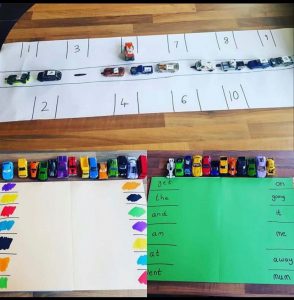 Park the blue car in number 8, park the blue car in the red space or drive the green car to mum – toy cars, or animals or figures, can become a playful learning experience.
Park the blue car in number 8, park the blue car in the red space or drive the green car to mum – toy cars, or animals or figures, can become a playful learning experience.
Learning intention
Develop recognition of numbers, colours or tricky words.
Activity
1. Make a car park using a large piece of paper, or on the ground outside using chalk, putting numbers, colours or words in the parking spaces.
2. Give you child a colour, number or word and ask them to park the car in the right parking space. When using the words, the children have to say the word in the space before parking in it.
3. The numbers could also be used as answers to sums for older children.
Sort the B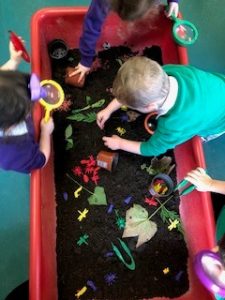 ugs Amy Wood
ugs Amy Wood
A great activity to help with numeracy, sorting and counting coloured bugs into the correct pots.
Learning intentions
Extending children’s mathematical development through the sorting of coloured bugs and developing fine motor skills using tweezers.
Activity
1. Resources: soil, magnifying glass, tweezers, coloured bugs, pots with colour.
2. Put soil into a tray and hide some coloured bugs (or other coloured items) in the soil.
3. Encourage children to use the tweezers (or their hands) to sort the bugs into the correct coloured pots.
Number Ground Art – Mechelle Caughey
It’s not only a pencil and paper that can be used to write numbers. This activity will stretch your child’s imagination to create temporary numbers using materials such as stones, sticks, leaves and feathers.
Learning Intentions
Children will be provided with opportunities to develop their natural curiosity about numbers and counting using natural loose parts.
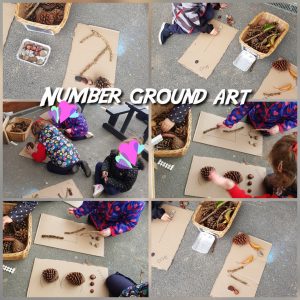 Activity
Activity
1. Draw numbers on a piece of cardboard or with chalk on the ground.
2. Give children a piece of paper with a number or dots on it and send them off on a hunt around the garden to collect natural loose objects to make the numbers or put the right number of items on the dots.
3. This will provide opportunities for mathematical discussion around the shape of numbers.
4. Get them to take a picture of their work and show it off to other family members and explain how they recognise and count numbers.
4. Feeding the Owls – Nicola Andrews
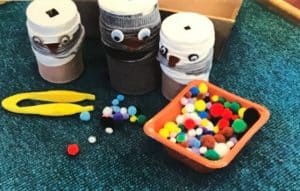 After making their own owls, children can feed the owls with pompoms (or different sized counters) using their fingers or tweezers (or even chop sticks) depending on ability.
After making their own owls, children can feed the owls with pompoms (or different sized counters) using their fingers or tweezers (or even chop sticks) depending on ability.
Learning Intentions
To develop fine motor skills and encourage mathematical thinking including counting, size, colour and patterns (e.g. pompoms).
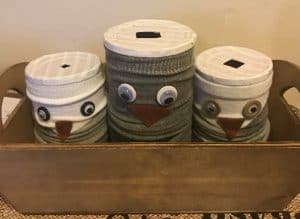 Activity
Activity
1. The owls can be made using coffee tins or something similar (ensuring they are safe to use).
2. The tins can be decorated using socks or scrap materials. Children can help design and make the owls (or any creature they like).
3. Cut holes of different sizes into the lid of the tins (cover the lids with insulating tape to ensure there were no rough edges around the holes).
4. Encourage the children to use their fingers or the tweezers to feed the owls one pompom (or counter) at a time, noting the different sized holes.
5. Measure It – Oonagh McLaughlin
Learning intentions
To understand and use the language of comparison
Activity
1. Find an object close to hand – for example, a pen, pencil or book.
2. Challenge your child to find a bigger object or a smaller one, a longer or shorter one, a thinner or thicker object or a heavier or lighter object.
3. Discuss and compare the objects that the child finds. How do they know that it is bigger, smaller? Do they need two hands or one hand to hold it? Is it bigger than their hand or can they fit it inside? Is it long or shorter than their little finger – what about their other fingers?
4. Words to use: big/bigger, small/smaller, long/longer, short/shorter, thin/thinner/, thick/thicker
5. How can we check? Using rulers, measuring tapes, scales?
6. Match it! – Oonagh McLaughlin
Learning intentions
To match shapes, number or letters.
Activity
1. Choose a shape/number/letter at the beginning of the day, e.g. the number 2.
2. Challenge your child to find this number on items throughout the home ,such as remote controls, post, books, labels, clocks, etc.
3. They could record this digitally by taking photographs. They could also record groups of 2 items, e.g. 2 tea cups, 2 toy cars, etc
4. Equally, you could take them on a number walk during their daily exercise where they could take notes of numbers in the environment such as on houses, bus stops, car registrations, etc. They could also record this digitally.
7. Post-it Challenge – Oonagh McLaughlin
Learning intentions
To examine and compare surface areas.
Activity
1. What things in your home can you cover with a post-it? What things are bigger than a post it? Can you record these? (drawing, writing a list, taking photos and sorting them into two albums on a phone/ipad).
2. How could you measure what the post-it will cover? (Using sugar cubes? Lego? Predict how many blocks you will need to cover items such as a seat/table/phone/box…. check to see if you were right)
3. Predict how many post-its would be needed to cover items. Include large items such as your bedroom floor/your quilt/your living room rug/the kitchen table/your whole house. Can you check? If you knew how many post-its would cover one brick, could you calculate how many were needed for a wall? or your whole house?
8. Shape Sort Match –Traci Hefferon
Match shapes to their outline
Learning intentions
To encourage children to explore the properties of different shapes and match them to their outlines.
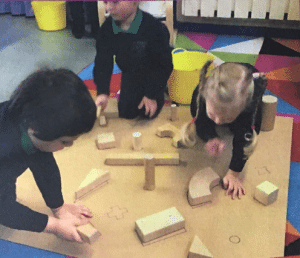 Activity
Activity
1. Find a selection of different shaped objects with your children.
2. Put the shapes on the ground or a piece of board and draw around their outline with chalk or a marker.
3. Mix the shapes up and encourage your children to find the shape that fits the outline.
4. Discuss the difference between shapes and compare their outlines using language such as large/small, long/short sides, curved/straight edges, etc.
